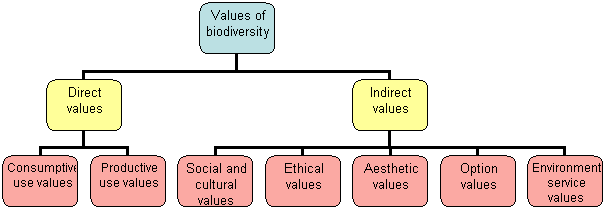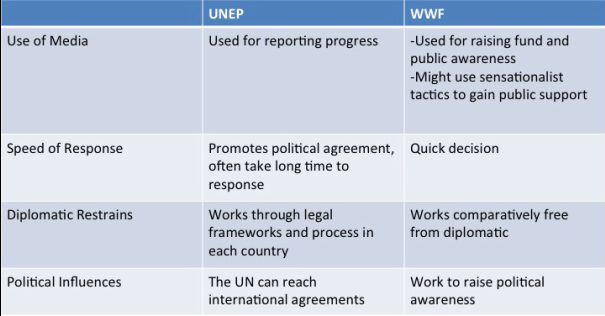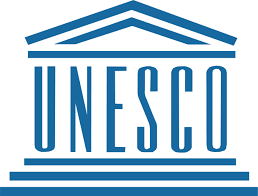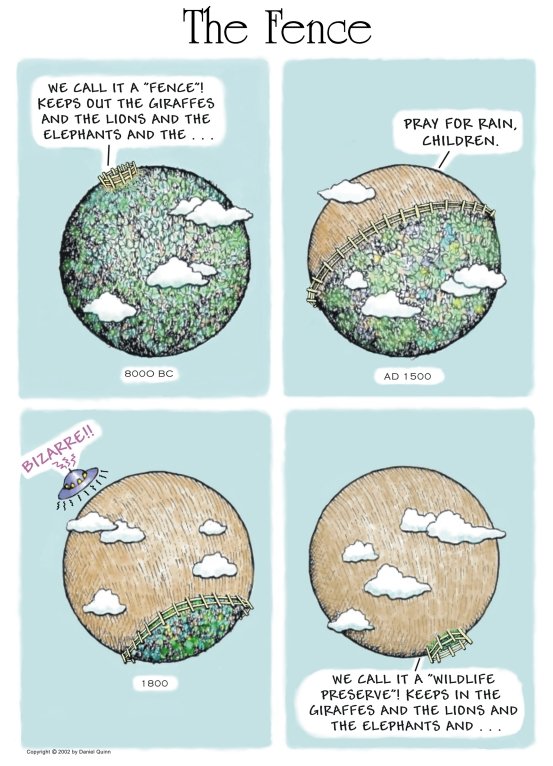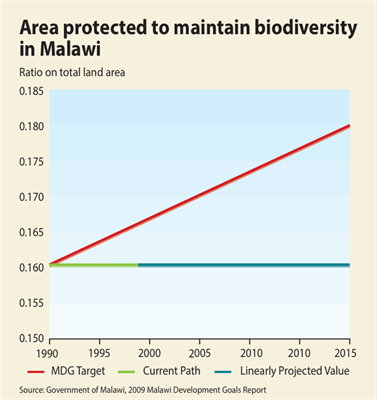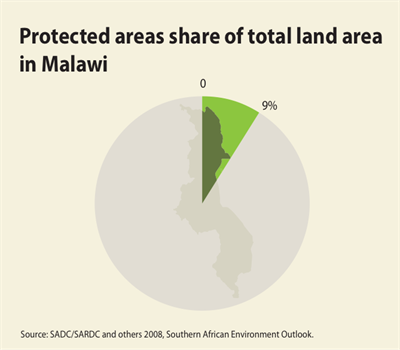topic 3.4: conservation of biodiversity
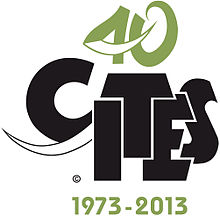 Image from http://en.wikipedia.org
Image from http://en.wikipedia.org
Life has existed on Earth for over 3.5 billion years. Over 95% of the species that ever existed have gone extinct. So why should we be concerned about current extinction rates and conserving biodiversity?
It has become clear that biodiversity is the cornerstone of our existence on Earth. It is also important to conserve biodiversity for the sake of our own curiosity and aesthetic appreciation.
In this unit you will consider arguments for preserving species and habitats based on ethical, aesthetic, genetic resources and commercial considerations. You will also look at the activities of intergovernmental and non-governmental organisations in preserving and restoring ecosystems. This unit is a minimum of 4 hours.
It has become clear that biodiversity is the cornerstone of our existence on Earth. It is also important to conserve biodiversity for the sake of our own curiosity and aesthetic appreciation.
In this unit you will consider arguments for preserving species and habitats based on ethical, aesthetic, genetic resources and commercial considerations. You will also look at the activities of intergovernmental and non-governmental organisations in preserving and restoring ecosystems. This unit is a minimum of 4 hours.
Significant Ideas:
- The impact of losing biodiversity drives conservation efforts.
- The variety of arguments given for the conservation of biodiversity will depend on EVSs.
- There are various approaches to the conservation of biodiversity, each with associated strengths and limitations
Big Questions:
- To what extent have the solutions emerging from this topic been directed at preventing environmental impacts, limiting the extent of the environmental impacts, or restoring systems in which environmental impacts have already occurred?
- What value systems can you identify at play in the causes and approaches to resolving the issues addressed in this topic?
- How does your own value system compare with others you have encountered in the context of issues raised in this topic?
- In what ways might the solutions explored in this topic alter your predictions for the state of human societies and the biosphere some decades from now?
- How do different conservation measures (e.g. in situ and ex situ) prevent environmental impacts, limit the extent of the environmental impacts, or restore systems in which environmental impacts have already occurred?
- How would a technocentric view of biodiversity differ from an ecocentric one? Ho do different EVSs affect approaches to conservation?
- If you are from a MEDC, how would your EVS differ from that of someone from a LEDC, or from someone who relies on the preservation of natural ecosystems for survival?
- Do you think that the conservation measures being taken today will be sufficient of preserve the Earth's biodiversity for the future?
Knowledge & Understanding:
3.4.U1 Arguments about species and habitat preservation can be based on aesthetic, ecological, economic, ethical and social justifications.
[Economic arguments for preservation often involve valuation of ecotourism, of the genetic resource, and commercial considerations of the natural capital. Ecological reasons may be related to the ecosystem. Ethical arguments are very broad, and can include the intrinsic value of the species or the utilitarian value.]
[Economic arguments for preservation often involve valuation of ecotourism, of the genetic resource, and commercial considerations of the natural capital. Ecological reasons may be related to the ecosystem. Ethical arguments are very broad, and can include the intrinsic value of the species or the utilitarian value.]
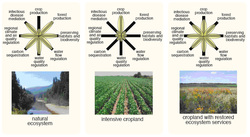 image from epa.gov
image from epa.gov
You should appreciate arguments based on ethical, aesthetic, genetic resource and commercial (including opportunity cost) considerations. You should also appreciate life support and ecosystem-support functions.
Habitat conservation for wild species is one of the most important issues facing the environment today — both in the ocean and on land. As human populations increase, land use increases, and wild species have smaller spaces to call home. More than half of Earth's terrestrial surface has been altered due to human activity, resulting in drastic deforestation, erosion and loss of topsoil, biodiversity loss, and extinction. Species cannot survive outside of their natural habitat without human intervention, such as the habitats found in a zoo or aquarium, for example. Preserving habitats is essential to preserving biodiversity.
Ecological
The values of biodiversity can be classified as either direct values or indirect values
Direct values - can be (relatively) easily calculated
Examples:
Indirect values - more difficult to calculate
Examples:
Habitat conservation for wild species is one of the most important issues facing the environment today — both in the ocean and on land. As human populations increase, land use increases, and wild species have smaller spaces to call home. More than half of Earth's terrestrial surface has been altered due to human activity, resulting in drastic deforestation, erosion and loss of topsoil, biodiversity loss, and extinction. Species cannot survive outside of their natural habitat without human intervention, such as the habitats found in a zoo or aquarium, for example. Preserving habitats is essential to preserving biodiversity.
Ecological
- Life-support service value e.g. stable climate
- Some species are keystone species, which if removed from the ecosystem can lead to many other species becoming extinct
- Species and habitat are direct natural capital, e.g. ecotourism
- Unknown value in the potential of the species for agriculture, medicine, genetic diversity and biotechnology
- Nature can provide inspiration for all kinds of artworks
- The idea of good stewardship (looking after the environment) and sustainable development for the good of future generations
- Intrinsic value of the environment or right of individuals or species to exist
The values of biodiversity can be classified as either direct values or indirect values
Direct values - can be (relatively) easily calculated
- goods harvested & destroyed for consumption (eating) or sale in a market
- generally physical commodities of some sort
- private goods - value accrues to the owner of the resource
Examples:
- food sources (‘heirloom varieties’ of many crops, i.e. corn/maize)
- natural products (medicines, textiles, fertilizers, pesticides, etc
Indirect values - more difficult to calculate
- stabilize ecosystems (negative feedback cycles)
- provide benefits but are not generally harvested/destroyed/sold
- usually services or processes which benefit everyone
- public goods - value accrues to society instead of individuals
Examples:
- ecosystem productivity (a.k.a. ecosystem services) i.e. soil aeration, pollination, fertilization, carbon sequestration, oxygen production ,climate regulation, etc
- scientific or educational value
- biological control (another example of negative feedback)
- gene sources
- environmental monitors
- recreation and ecotourism
- human health - possible future medical applications
- rights of indigenous peoples
- intrinsic (ethical) value - biorights
3.4.U2 International, governmental and non-governmental organizations (NGOs) are involved in conserving and restoring ecosystems and biodiversity, with varying levels of effectiveness due to their use of media, speed of response, diplomatic constraints, financial resources and political influence.
[International conventions on conservation and biodiversity have been adopted over the past decades.]
[International conventions on conservation and biodiversity have been adopted over the past decades.]

Consider the United Nations Environment Programme (UNEP) as an intergovernmental organization and the World Wide Fund for Nature (WWF) and Greenpeace as non‑governmental organizations. Compare and contrast UNEP and WWF in terms of use of the media, speed of response, diplomatic constraints and political influence. Consider also recent international conventions on biodiversity (for example, conventions signed at the Rio Earth Summit (1992) and subsequent updates).
UNEP: set up the Intergovernmental Panel on Climate Change (IPCC) and drove the Montreal Protocol for phasing out production of ozone-depleting substances.
There are also many other economic coalitions for example ASEAN, the EU, the African Union, and OPEC, some of which are working for sustainable development and environmental protection. NGOs are now having more of a global impact, e.g. Greenpeace, and WWF. Institutional Inertia has been a block to change but the power of people wanting change and voting for politicians who say they will deliver it may be able to begin to reverse the degradation of the planet.
The World Conservation Strategy (WCS)
- The WCS was published by IUCN, UNEP, and WWF in 1980, which presented a joint effort and integrated approach to conservation. Its aims were to: maintain essential ecological processes and life support systems; and preserve genetic diversity. It called for international, national, and regional efforts to balance development with conservation of the world’s living resources. Many countries adopted the WCS strategies and developed their own too.
In 1982, The UN adopted the UN World Charter for Nature which focused on the following principles: nature shall be respected; genetic viability on earth shall not be compromised; all areas on Earth are subject to these principles; ecosystems and organisms shall be managed to achieve and maintain optimum sustainable productivity; and nature shall be secured against degradation caused by warfare or hostile activities.
At the UN Earth Summit in Rio in 1992, 179 heads of government signed their countries to Agenda 21. Agenda 21 is a guide for individuals, businesses, and governments in making choices for development that help society and the environment. It focuses on four main principles:
- Social and economic dimensions: developing countries; poverty; population; and integrating environment and development.
- Conservation and management of resources: atmosphere, land, agriculture, biotechnology, toxic chemicals, and radioactive waste.
- Strengthening the role of major groups: women, children, indigenous people, NGOs, etc..
- Means of implementation: finance, technology, science, legal measures, etc…
The UN Johannesburg Summit on sustainable development in 2002 was intended to consolidate the Rio one however little action came out of its deliberations. In 2000, however, the UN Millennium Summit was the largest ever gathering of world leaders who agreed to set time-bound and measurable goals for combating poverty, hunger, disease, illiteracy, environmental degradation and discrimination against women. This became known as the Millennium Development Goals. The follow-up in 2005 at the World Summit in New York outlined a series of global priorities for action and recommended that each country prepare its own national strategy for the conservation of natural resources for long-term human welfare.
Government organizations (GO’s) -
- part or branch of a national, state, department, or local government
- ultimately responsible to the voter
- have the authority to prosecute violations of regulations within their jurisdiction
- examples: Fish and Wildlife Service, Department of Agriculture, Eaux et Forets (Water and Forests), and other branches of local and national government agencies
- generally a part of multi-national organizations, especially the United Nations
- most agreements are not legally binding under international law, but each signatory country is responsible for legislating and regulating conservation efforts within their own territory
- the UN and other IGO’s
- Examples: UNEP (United Nations Environment Programme), CITES, IPCC (Intergovernmental Panel on Climate Change)
- work independently from governments to protect threatened species and areas
- frequently form partnerships with GO’s and IGO’s to more effectively reach their targeted goals. Examples: WWF, Greenpeace,
3.4.U3 Recent international conventions on biodiversity work to create collaboration between nations for biodiversity conservation.

The Convention on Biological Diversity (CBD) was inspired by the world community's growing commitment to sustainable development. It represents a dramatic step forward in the conservation of biological diversity, the sustainable use of its components, and the fair and equitable sharing of benefits arising from the use of genetic resources.
The Convention on Biological Diversity (CBD), known informally as the Biodiversity Convention, is a multilateral treaty. The Convention has three main goals:
The Convention was opened for signature at the Earth Summit in Rio de Janeiro on 5 June 1992 and entered into force on 29 December 1993.
Each of the biodiversity-related conventions works to implement actions at the national, regional and international level in order to reach shared goals of conservation and sustainable use. In meeting their objectives, the conventions have developed a number of complementary approaches (site, species, genetic resources and/or ecosystem-based) and operational tools (e.g., programmes of work, trade permits and certificates, multilateral system for access and benefit-sharing, regional agreements, site listings, funds).
The Convention on Biological Diversity (CBD), known informally as the Biodiversity Convention, is a multilateral treaty. The Convention has three main goals:
- conservation of biological diversity (or biodiversity);
- sustainable use of its components; and
- fair and equitable sharing of benefits arising from genetic resources
The Convention was opened for signature at the Earth Summit in Rio de Janeiro on 5 June 1992 and entered into force on 29 December 1993.
Each of the biodiversity-related conventions works to implement actions at the national, regional and international level in order to reach shared goals of conservation and sustainable use. In meeting their objectives, the conventions have developed a number of complementary approaches (site, species, genetic resources and/or ecosystem-based) and operational tools (e.g., programmes of work, trade permits and certificates, multilateral system for access and benefit-sharing, regional agreements, site listings, funds).
3.4.U4 Conservation approaches include habitat conservation, species-based conservation and a mixed approach.
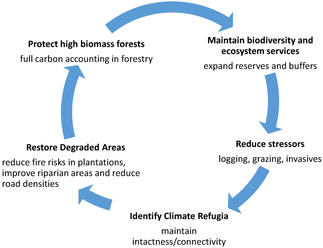
The fundamental characteristics that determine a region's inherent conservation value are vulnerability, irreplaceability and contribution towards global ecosystem services. Properly managed protected areas are the epicentre for sustaining the very ecosystem services on which mankind is dependent for survival.
Species based approach (In situ) - focuses on conserving the species in their natural habitat.
Habitat based approach (Ex situ) - improve the probability of survival of the species by taking them out of their habitat and breeding them in captivity; with the intention of re-introducing them back into the wild in the future.
Mixed approach
Combining both in situ (protected areas) and ex situ (zoos) methods can be the best solution for species conservation
Species based approach (In situ) - focuses on conserving the species in their natural habitat.
- CITI (Conservation on International Trade in Endangered Species of Wild Fauna and Flora
- Flagship species
- Keystone species
Habitat based approach (Ex situ) - improve the probability of survival of the species by taking them out of their habitat and breeding them in captivity; with the intention of re-introducing them back into the wild in the future.
- Captive breeding and zoos
- Botanical gardens and seed banks
Mixed approach
Combining both in situ (protected areas) and ex situ (zoos) methods can be the best solution for species conservation
3.4.U5 Criteria for consideration when designing protected areas include size, shape, edge effects, corridors, and proximity to potential human influence.
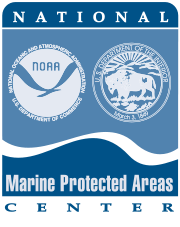
In effect, protected areas may become “islands” within a country and will normally lose some of their diversity. The principles of island biogeography might be applied to the design of reserves. Need to remember that ecosystems are rarely at a stable point. They are hard to lock them or protect them from change. This means they are in a nonequilibrium state. Ecosystems which experience frequent or moderate disturbance have the greatest diversity. This is an intermediate disturbance hypothesis.Most reserves are considered to be habitat islands in a sea of developed or fragmented lands.
Appropriate criteria should include size, shape, edge effects, corridors and proximity.
Appropriate criteria should include size, shape, edge effects, corridors and proximity.
- size - larger space allows for larger populations and gene pools, and a wider variety of species
- shape - round is better than all other shapes because it reduces the edge effect
- edge effects - less edge is better; edge creates differences in the structure of an ecosystem, called an ecotone (an area where 2 habitats meet), which influences what may successfully live there.
- corridors - provide safe passage between protected areas
- proximity - if protected areas are close to other protected areas, they are more effective than isolated islands
3.4.U6 Alternative approaches to the development of protected areas are species-based conservation strategies including: CITES, captive breeding and reintroduction programmes, and zoos, selection of “charismatic” species to help protect others in an area (flagship species), selection of keystone species to protect the integrity of the food web.

CITES (the Convention on International Trade in Endangered Species of Wild Fauna and Flora) is an international agreement between governments set up to protect the many species which were becoming endangered because of international trade. Its aim is to ensure that international trade in specimens of wild animals and plants does not threaten their survival. Governments sign up voluntarily and establish their own national laws to monitor trade. Species are grouped according to how threatened they are by international trade.
Captive breeding, reintroduction and zoos
While captive breeding ensures that species do not go exist we can not keep every species in captivity. The re-introduction of captive-bred species is also a complex process. Programs to re-introduce populations or establish new ones are very expensive and difficult. Criticisms of such programmes are that they waste money, are unnecessary, poorly run or unethical. But they are often the best chance that a species has to avoid extinction. These programmes also create employment and promote education. Sometimes it is impossible to reintroduce species to their native habitat because it has been destroyed, in which case captive-breeding and zoos are there best option. Zoos are often criticized and rightly so as animals are kept in close confinement, in small cages or treated with cruelty. But there are many benefits to zoos as they produce employment, income for the research and protection of species, and educate the public in order to promote sustainable development and protection of biodiversity.
Aesthetic versus ecological value
Aesthetically there are many areas of natural beauty which need to protect. The environment is a source of income in the form of ecotourism as well as the legacy that we leave future generations. The species-based approach focuses on specific species and not the environment as a whole. Every species has an ecological value as it provides a service to its environment (niche) and thus a species based approach is very important. Aesthetic importance of species is important to us as humans however the ecological value of a species outweighs our extrinsic needs for it and we need to appreciate the intrinsic value of every species.
Flagship species
Charismatic species selected to appeal to the public and thereby help to protect other species in an area. These species are charismatic, recognized, popular, large and furry but may not have significant role, They are used to ask for funds
Keystone species
Species that are vital for the continuing function of the ecosystem. Without these species the ecosystem may collapse. Their disappearance from ecosystem has a far greater impact than to the system. They are not proportional to their numbers/biomass. These species can be difficult to identify
Umbrella species:
These are often large species requiring large habitat areas. Protecting the habitat of this species also protects the habits of other species.The Giant panda is both a flagship species and an umbrella species.
- Appendix І: species can not be traded internationally as they are threatened by extinction.
- Appendix ІІ: species can be traded internationally but within strict regulations.
- Appendix ІІІ: species included at the request of a country which then needs the cooperation of other countries to help prevent the illegal exploitation.
Captive breeding, reintroduction and zoos
While captive breeding ensures that species do not go exist we can not keep every species in captivity. The re-introduction of captive-bred species is also a complex process. Programs to re-introduce populations or establish new ones are very expensive and difficult. Criticisms of such programmes are that they waste money, are unnecessary, poorly run or unethical. But they are often the best chance that a species has to avoid extinction. These programmes also create employment and promote education. Sometimes it is impossible to reintroduce species to their native habitat because it has been destroyed, in which case captive-breeding and zoos are there best option. Zoos are often criticized and rightly so as animals are kept in close confinement, in small cages or treated with cruelty. But there are many benefits to zoos as they produce employment, income for the research and protection of species, and educate the public in order to promote sustainable development and protection of biodiversity.
Aesthetic versus ecological value
Aesthetically there are many areas of natural beauty which need to protect. The environment is a source of income in the form of ecotourism as well as the legacy that we leave future generations. The species-based approach focuses on specific species and not the environment as a whole. Every species has an ecological value as it provides a service to its environment (niche) and thus a species based approach is very important. Aesthetic importance of species is important to us as humans however the ecological value of a species outweighs our extrinsic needs for it and we need to appreciate the intrinsic value of every species.
Flagship species
Charismatic species selected to appeal to the public and thereby help to protect other species in an area. These species are charismatic, recognized, popular, large and furry but may not have significant role, They are used to ask for funds
- giant panda
- meerkats
- gorillas
- take priority over others
- become extinct if we failed
- in conflict with indigenous people
Keystone species
Species that are vital for the continuing function of the ecosystem. Without these species the ecosystem may collapse. Their disappearance from ecosystem has a far greater impact than to the system. They are not proportional to their numbers/biomass. These species can be difficult to identify
- sea otter eating sea urchins
- beavers engineers dams
- elephants removing trees so grasses can grow
Umbrella species:
These are often large species requiring large habitat areas. Protecting the habitat of this species also protects the habits of other species.The Giant panda is both a flagship species and an umbrella species.
Your browser does not support viewing this document. Click here to download the document.
3.4.U7 Community support, adequate funding and proper research influence the success of conservation efforts.
 image www.fws.gov
image www.fws.gov
The community-based conservation approach involves initiatives aimed at conserving biodiversity but also letting local people benefit from the resources. Some community-based conservation approaches include signing of resource use agreements, local people given money for infrastructural development and local people given a percentage of revenue generated from tourism activities in the park.
3.4 U8 The location of a conservation area in a country is a significant factor in the success of the conservation effort. Surrounding land use for the conservation area and distance from urban centres are important factors for consideration in conservation area design.
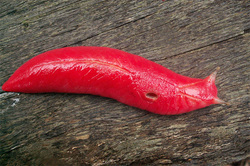
The granting of protected status to a species or ecosystem is no guarantee of protection without community support, adequate funding and proper research. Consider a specific local example.
Due to pressures on habitat and decline in populations some species have become vulnerable. The legislation provides for the protection of certain species of wild plants, birds and animals. The degree of protection could be partial (for example: prohibiting trade, closed seasons) or full, in which case the disturbance, killing or injuring of just one of the species could constitute an offence. Their associated breeding and sheltering places are also protected.
The list of protected species under domestic legislation is subject to a five-yearly review whereby species can be added to, or removed from the schedules of protected species.
For each case study, be able to outline and discuss responses to the following questions:
Due to pressures on habitat and decline in populations some species have become vulnerable. The legislation provides for the protection of certain species of wild plants, birds and animals. The degree of protection could be partial (for example: prohibiting trade, closed seasons) or full, in which case the disturbance, killing or injuring of just one of the species could constitute an offence. Their associated breeding and sheltering places are also protected.
The list of protected species under domestic legislation is subject to a five-yearly review whereby species can be added to, or removed from the schedules of protected species.
For each case study, be able to outline and discuss responses to the following questions:
- Name the protected area and its location
- Which species is the area designed to protect?
- Why is/are the species threatened?
- How and why has the protected area been successful?
- Weight the pros and cons of each of the following aspects of the area
i. Size
ii. Shape
iii. Edge effect
iv. Corridors
v. Human proximity (fragmentation)
vi. Involvement of local communities - Clearly state whether each aspects’ pros outweigh its cons or vice versa
- Reach an overall conclusion and support it with reasons
- Describe how the criteria used to design protected areas have influenced the success of each case study.
|
Terrestrial and marine protected areas (% of total territorial area) in Malawi was 15.02 as of 2010. Its highest value over the past 20 years was 15.02 in 2010, while its lowest value was 15.02 in 1990.
|
| ||||||
Application & Skills
3.4.A1 Explain the criteria used to design and manage protected areas.
Many protected areas in the past were set up on land that no one else wanted. It may have been poor agricultural land, not near areas of high human density, or land that was degraded in some way. This has led to some problems in the effectiveness of protecting biodiversity. UNESCO’s Man and the Biosphere Programme (MAB) started in 1970 which created a network of international reserves in over 100 countries.
Island biogeography refers to the isolation of species when they are placed in a protected area or reserves. When protected areas are created there will be some decrease in biodiversity as species are isolated from each other. The following criteria are based upon the principles of island biogeography, where the increased protection of species is the priority.
Criteria that conservationists now use when planning a protected area or national park are:
Some reserves have buffer zones, which are areas around the core reserve which is transitional. Some farming, extraction of natural resources, e.g. selective logging can take place here. The core of the reserve (centre) is left undisturbed and organisms should be safer this way.
Island biogeography refers to the isolation of species when they are placed in a protected area or reserves. When protected areas are created there will be some decrease in biodiversity as species are isolated from each other. The following criteria are based upon the principles of island biogeography, where the increased protection of species is the priority.
Criteria that conservationists now use when planning a protected area or national park are:
- Size: how large should it be to protect the species?
- Numbers: how many individuals of an endangered species must be protected?
- Fragmentation: Is it better to have one larger area or many smaller ones? A large reserve will contain sufficient numbers of wide-ranging species, minimize edge effects and provide more habitats for more species. But several smaller reserves that are well placed may be able to provide more diverse habitats for more diverse populations of rare species than a larger block.
- Edge effects: how to have more interior space per edge? More internal area away from human activities. Involves decreasing the circumference-to-area ration. Edge effects occur at ecotones (where two habitats meet and there is a change near the boundary). More species exist at ecotones as species from different habitats converge leading to increased predation and competition. Long thin reserves have a large edge effect while circular reserves have the least.
- Shape: What is the best shape? Often determined by physical features (e.g. mountains)
- Proximity: How close is it to other reserves? How close is it to humans or human activities?
- Corridors: Should reserves be joined by corridors? Corridors are strips of protected land which link reserves. These allow individuals to move freely from reserve to reserve and therefore increase the size of the gene pool and allow for seasonal migration. There are disadvantages as diseases are more easily spread and it makes hunting/poaching easier in these corridors, which are harder to protect than reserves.
Some reserves have buffer zones, which are areas around the core reserve which is transitional. Some farming, extraction of natural resources, e.g. selective logging can take place here. The core of the reserve (centre) is left undisturbed and organisms should be safer this way.
3.4.A2 Evaluate the success of a given protected area.
[A specific example of a protected area and the success it has achieved should be studied.]
[A specific example of a protected area and the success it has achieved should be studied.]
Sichuan giant panda sanctuary
Location: Sichuan Province, China. About 900 000 hectares of national reserves which are the habitat for the giant panda as well as red panda and snow and clouded leopards. It is a World Heritage Site.
Habitat: there are about giant 1600 pandas living there and approximately 6000 plant species. But the pandas habitat is shrinking as people fell the bamboo forests and degrade the habitat.
History: In the 1960s errors were made in trying to protect the pandas and many were caged in hopes that they would breed in captivity. Captive breeding is more successful now as pandas are house in larger areas.
Actions taken: Human populations have now been moved out of the reserves and laws on gun use tightened. Panda numbers have now started to increase but are not yet out of trouble. Educating the public has been very important and ecotourism has assisted greatly in funding the research and protection of the giant panda, and the reserve as a whole.
Concerns: as the giant panda has a specialized diet of almost entirely bamboo, it means that their habitat is limited. If the bamboo goes they will starve.
Location: Sichuan Province, China. About 900 000 hectares of national reserves which are the habitat for the giant panda as well as red panda and snow and clouded leopards. It is a World Heritage Site.
Habitat: there are about giant 1600 pandas living there and approximately 6000 plant species. But the pandas habitat is shrinking as people fell the bamboo forests and degrade the habitat.
History: In the 1960s errors were made in trying to protect the pandas and many were caged in hopes that they would breed in captivity. Captive breeding is more successful now as pandas are house in larger areas.
Actions taken: Human populations have now been moved out of the reserves and laws on gun use tightened. Panda numbers have now started to increase but are not yet out of trouble. Educating the public has been very important and ecotourism has assisted greatly in funding the research and protection of the giant panda, and the reserve as a whole.
Concerns: as the giant panda has a specialized diet of almost entirely bamboo, it means that their habitat is limited. If the bamboo goes they will starve.
3.4.A3 Evaluate different approaches to protecting biodiversity.
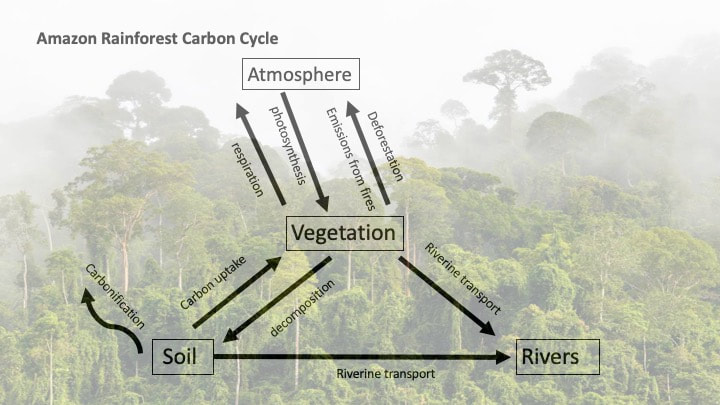
The preservation approach, which aims at setting aside National Parks to exclude human activities except for tourism. Through this approach, direct use of natural resources in the park for commercial or subsistence purposes is prohibited. This type of approach is often referred to as the “protectionism approach” or “the fines and fences” approach. The preservation approach aims at excluding human activities considered inimical to the objectives of conserving biodiversity in National Parks. The preservation approach was the most dominant approach until the 1980s, but in some National Parks, it has now been substituted by the second approach called the community-based conservation approach that allows people (especially those that neighbor National Parks) to benefit socially or economically from parks
The community-based conservation approach involves initiatives aimed at conserving biodiversity in the park but also letting local people benefit from the park. Some of the initiatives involved in the community-based conservation approach include signing of resource use agreements such as in the Rwenzori Mountains National Park which allow local people who neighbor National Parks to have access to specific resources from the park for subsistence use. In other cases, local people are given money for infrastructural development, such as in Integrated Conservation and Development Initiative in Korup National Park in Cameroon. And in other National Parks such as Pendjari National Park in Benin, local people are given a percentage of revenue generated from tourism activities in the park.
You should be aware of the relative strengths and weaknesses of:
State the strength/weakness by:
Conservation approaches provide for:
Areas of particular concern include:
Understanding the benefits and limitations of using conservation approaches for achieving biodiversity conservation will help ensure that the finite resources available for biodiversity conservation and sustainable development are used as strategically and effectively as possible to maintain the multiple components of biodiversity and to support human well-being.
The community-based conservation approach involves initiatives aimed at conserving biodiversity in the park but also letting local people benefit from the park. Some of the initiatives involved in the community-based conservation approach include signing of resource use agreements such as in the Rwenzori Mountains National Park which allow local people who neighbor National Parks to have access to specific resources from the park for subsistence use. In other cases, local people are given money for infrastructural development, such as in Integrated Conservation and Development Initiative in Korup National Park in Cameroon. And in other National Parks such as Pendjari National Park in Benin, local people are given a percentage of revenue generated from tourism activities in the park.
You should be aware of the relative strengths and weaknesses of:
- the Convention on International Trade in Endangered Species (CITES);
- captive breeding and reintroduction programmes
- zoos and aesthetic versus ecological value
State the strength/weakness by:
- Giving at least 1 specific Evidence/Example for the strength/weakness
- Giving a brief statement why it’s a strong/weak example
- You should have a least 2 strengths and 2 weaknesses that follow this pattern
Conservation approaches provide for:
- the development of broader constituencies for conservation and expanded possibilities to influence decision-making;
- opportunities to add or create new value to protected areas;
- opportunities to manage ecosystems sustainably outside of protected areas.
Areas of particular concern include:
- species without utilitarian or economic value;
- ecological processes that do not directly benefit people; and critical ecological functions that may be undermined in attempts to optimize a target service.
Understanding the benefits and limitations of using conservation approaches for achieving biodiversity conservation will help ensure that the finite resources available for biodiversity conservation and sustainable development are used as strategically and effectively as possible to maintain the multiple components of biodiversity and to support human well-being.
Key Terms
|
species
UNEP community stewardship ecotourism ecotone gradual edge buffer zone minimum viable pop. seed bank in situ |
habitat
WWF CITE genetic resource nutrient cycling edge effect biodiversity security botanical garden ex situ |
aesthetic
Greenpeace captive breeding gene pool water purification reserve forest interior scale captive breeding keystone species SLOSS |
intergovernmental
Rio Earth Summit ethical natural selection ecoterrorism zonation migration ecological process reintroduction flagship species |
NGOs
island biogeography life support intrinsic value corridors abrupt change invasive species historic range zoo intervention |
Classroom Materials
Strength and Weakness of Conservation programs handout
Resources and Their Exploitation project
Protected Area Case Studies worksheet
SeaWorld responds to questions about captive orcas article
CITES: solving the extinction crisis article
Do Corridors Have Value in Conservation Case Study
Captive breeding case studies from National Geographic
Suffering unseen: The dark truth behind wildlife tourism from National Geographic
Case Studies
Strength and Weakness of Conservation programs handout
Resources and Their Exploitation project
Protected Area Case Studies worksheet
SeaWorld responds to questions about captive orcas article
CITES: solving the extinction crisis article
Do Corridors Have Value in Conservation Case Study
Captive breeding case studies from National Geographic
Suffering unseen: The dark truth behind wildlife tourism from National Geographic
Case Studies
- One detailed case study evaluating the success of a protected area
- Examples of named keystone and charismatic species
Powerpoint and Notes Adapted from Brad Kremer, P Brooks and Ms. McCrindle
Your browser does not support viewing this document. Click here to download the document.
Your browser does not support viewing this document. Click here to download the document.
Correct use of terminology is a key skill in ESS. It is essential to use key terms correctly when communicating your understanding, particularly in assessments. Use the quizlet flashcards or other tools such as learn, scatter, space race, speller and test to help you master the vocabulary.
Useful Links
Science Sauce Topic 3.4 Shape of Nature Reserves
Preserving Biodiversity - National Geographic
Habitat Preservation - Wildlife Research
Quizlet Values of Biodiversity
IUCN Global Protection Project
Man and The Biosphere Program - UNESCO
The SLOSS Debate - About.com
CITE
In The News
A Plan to Save Wildlife May Have Done More Harm Than Good - Atlantic, Nov 2020
Should we cull one species to save another? - Guardian June 2020
Illegal wildlife trade campaign enlists tourists - BBC May 2016
Conservation of Biodiversity - Knowledge Project Carol Ann Kearns (Department of Ecology and Evolutionary Biology, University of Colorado at Boulder) © 2010 Nature Education
Traffic Noise is Bad for Foraging Bats - BBC Science News 17 Nov 2010 (noise pollution)
Citation: Kearns, C. (2010) Conservation of Biodiversity. Nature Education Knowledge 3(10):
New study questions 'biodiversity hotspot' approach to wildlife conservation - Stanford News 17 Jan 2007
Species vs ecosystems: save the tiger or focus on the bigger issues? - Ecologist 20 Jan 2011
What is the point in preserving endangered species that have no practical use to humans, apart from their aesthetic appeal or their intellectual interest to biologists? - Scientific America Oct 21, 1999
- International-mindedness:
TOK:
- This topic raises some engaging issues of debate concerning the moral justification for exploiting species and the moral imperative for conserving them.
- Do other organisms have a right to moral consideration? How is this justified?
- Do panda bears have a greater right than lichens? What about the rights of “pest” or pathogenic organisms?
- To what extent are these arguments based upon emotion and to what extent upon reason? And how does this affect their validity?
Video Clips
Malawi was recently exposed as a transit route and distribution hub for ivory traffickers and has been implicated in the biggest ivory seizures of all time. But it’s not just organised criminal syndicates that are exploiting the nation. Over 90 ivory cases have been recorded in the last 5 years.
In this film, H.E. President Peter Mutharika leads Ambassadors, High Commissioners and Honorary Consuls to call on all citizens, residents and visitors to say no to ivory trade. Missions backing the initiative are Belgium, Brazil, China, Egypt, Germany, Great Britain, India, Ireland, Italy, Japan, Mozambique, Korea, South Africa, Spain, Tanzania, the United States of America and Zambia. Belgium, Mozambique, and Italy have also pledged their support..
This film was put together by the Malawi Government, Lilongwe Wildlife Fund with the help of Bishop Mackenzie International School.
In this film, H.E. President Peter Mutharika leads Ambassadors, High Commissioners and Honorary Consuls to call on all citizens, residents and visitors to say no to ivory trade. Missions backing the initiative are Belgium, Brazil, China, Egypt, Germany, Great Britain, India, Ireland, Italy, Japan, Mozambique, Korea, South Africa, Spain, Tanzania, the United States of America and Zambia. Belgium, Mozambique, and Italy have also pledged their support..
This film was put together by the Malawi Government, Lilongwe Wildlife Fund with the help of Bishop Mackenzie International School.
CITES, the Convention on International Trade in Endangered Species of Wild Fauna and Flora, helps to ensure the survival of threatened species of plants and animals on a global level. This video outlines how CITES accomplishes this via its Three Appendix system. If you are interested in pet husbandry, botany, and conservation, this brief overview of CITES policy may help to advance your hobby.
World Wildlife Fund
The United Nations Environment Programme (UNEP) is an international institution (a programme, rather than an agency of the UN) that coordinates United Nations environmental activities, assisting developing countries in implementing environmentally sound policies and practices. It was founded as a result of the United Nations Conference on the Human Environment in June 1972 and has its headquarters in the Gigiri neighborhood of Nairobi, Kenya. Its activities cover a wide range of issues regarding the atmosphere, marine and terrestrial ecosystems, environmental governance and green economy.
We are passionate about protecting the Earth -- the only life support system we have. And we will take peaceful, direct action to protect this fragile planet and promote the solutions for a green and peaceful future.
3 March, the day of the adoption of the Convention on International Trade in Endangered Species of Wild Fauna and Flora (CITES), as World Wildlife Day, which proposed by Thailand, to celebrate and raise awareness of the world’s wild fauna and flora. -
Discover more about the importance of plants to our lives and how the Millennium Seed Bank Partnership is helping to save wild plants and habitats for our future.
Our planet was once populated by megafauna, big top-of-the-food-chain predators that played their part in balancing our ecosystems.
By piecing together a complex ecological puzzle, biologist Willie Smits believes he has found a way to re-grow clearcut rainforest in Borneo, saving local orangutans -- and creating a thrilling blueprint for restoring fragile ecosystems.
The Endangered Species Act of 1973 is by far the most significant piece of endangered species legislation and is considered one of the world's most important conservation laws.
Hank wraps up the Crash Course on ecology by taking a look at the growing fields of conservation biology and restoration ecology, which use all the kung fu moves we've learned about in the past eleven weeks and apply them to protecting ecosystems and to cleaning up the messes that we've already made.
The Banc d'Arguin National Park, a World Heritage marine site in Mauritania, is one of the largest protected areas in West Africa, supported under the "Tides of Time" Partnership between Jaeger-LeCoultre, The International Herald Tribune and UNESCO World Heritage Center.
Andrew Currie discusses the importance of the preservation of wildlife now, and in the future
Wildlife Management Areas (WMAs), which are community owned and managed conservation areas, have emerged as the best hope for mitigating human-wildlife conflict outside protected areas
